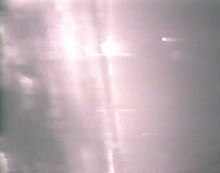
The AIM-54 Phoenix is an American radar-guided, long-range air-to-air missile (AAM), carried in clusters of up to six missiles on the Grumman F-14 Tomcat, its only operational launch platform.
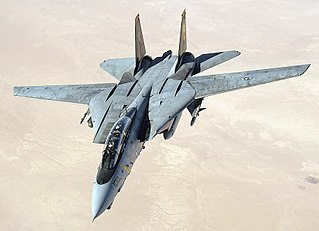
The Grumman F-14 Tomcat is an American carrier-capable supersonic, twin-engine, two-seat, twin-tail, all-weather-capable variable-sweep wing fighter aircraft. The Tomcat was developed for the United States Navy's Naval Fighter Experimental (VFX) program after the collapse of the General Dynamics-Grumman F-111B project. A large and well-equipped fighter, the F-14 was the first of the American Teen Series fighters, which were designed incorporating air combat experience against MiG fighters during the Vietnam War.

An interceptor aircraft, or simply interceptor, is a type of fighter aircraft designed specifically for the defensive interception role against an attacking enemy aircraft, particularly bombers and reconnaissance aircraft. Aircraft that are capable of being or are employed as both ‘standard’ air superiority fighters and as interceptors are sometimes known as fighter-interceptors. There are two general classes of interceptor: light fighters, designed for high performance over short range; and heavy fighters, which are intended to operate over longer ranges, in contested airspace and adverse meteorological conditions. While the second type was exemplified historically by specialized night fighter and all-weather interceptor designs, the integration of mid-air refueling, satellite navigation, on-board radar and beyond visual range (BVR) missile systems since the 1960s has allowed most frontline fighter designs to fill the roles once reserved for specialised night/all-weather fighters.

The Mikoyan-Gurevich MiG-23 is a variable-geometry fighter aircraft, designed by the Mikoyan-Gurevich design bureau in the Soviet Union. It is a third-generation jet fighter, alongside similar Soviet aircraft such as the Su-17 "Fitter". It was the first Soviet fighter to field a look-down/shoot-down radar, the RP-23 Sapfir, and one of the first to be armed with beyond-visual-range missiles. Production started in 1969 and reached large numbers with over 5,000 aircraft built, making it the most produced variable-sweep wing aircraft in history. The MiG-23 remains in limited service with some export customers.

The Mikoyan-Gurevich MiG-25 is a supersonic interceptor and reconnaissance aircraft that is among the fastest military aircraft to enter service. Designed by the Soviet Union's Mikoyan-Gurevich bureau, it is an aircraft built primarily using stainless steel. It was to be the last plane designed by Mikhail Gurevich, before his retirement.

In the first Gulf of Sidra incident, 19 August 1981, two Libyan Su-22 Fitters fired upon two U.S. F-14 Tomcats and were subsequently shot down off the Libyan coast. Libya had claimed that the entire Gulf was their territory, at 32° 30′ N, with an exclusive 62-nautical-mile fishing zone, which Libyan leader Muammar Gaddafi asserted as "The Line of Death" in 1973. Two further incidents occurred in the area in 1986 and in 1989.

LANTIRN is a combined navigation and targeting pod system for use on the United States Air Force fighter aircraft—the F-15E Strike Eagle and F-16 Fighting Falcon manufactured by Martin Marietta. LANTIRN significantly increases the combat effectiveness of these aircraft, allowing them to fly at low altitudes, at night and under-the-weather to attack ground targets with a variety of precision-guided weapons.

The Douglas F6D Missileer was a proposed carrier-based fleet defense fighter designed by Douglas Aircraft Company in response to a 1959 United States Navy requirement. It was designed to be able to loiter for extended periods at a relatively long distance from the Navy's aircraft carriers, engaging hostile aircraft 100 miles (160 km) away with its powerful radar and long-range missiles. Since the enemy would be fired on long before they reached visual range, the aircraft had little dogfighting capability and was strictly subsonic. When doubts were expressed about the Missileer's ability to defend itself after firing its missiles, the value of the project was questioned, leading to its cancellation. Some of the Missileer's systems, primarily the engines, radar, and missiles, continued development in spite of the cancellation, eventually emerging on the ill-fated General Dynamics–Grumman F-111B and successful Grumman F-14 Tomcat years later.

Strike Fighter Squadron 213 (VFA-213) Blacklions is an aviation unit of the United States Navy based at Naval Air Station Oceana, Virginia. It was established in 1955 and is currently equipped with the F/A-18F Super Hornet. The squadron is assigned to Carrier Air Wing Eight and uses the radio callsign Lion.

Strike Fighter Squadron 32 (VFA-32), nicknamed the "Fighting Swordsmen" are a United States Navy strike fighter squadron presently flying the F/A-18F Super Hornet and based ashore at Naval Air Station Oceana. Their radio callsign is Gypsy and their tail code is AC. The Fighting Swordsmen of VFA-32 are the 2023 recipients of the Mutha Fighter Spirit Award, awarded annually at the Navy’s Strike Fighter Ball in Norfolk, VA.

Strike Fighter Squadron 2 (VFA-2) also known as the "Bounty Hunters" is a United States Navy F/A-18F Super Hornet strike fighter squadron based at Naval Air Station Lemoore, California. Their tail code is NE and their callsign is "Bullet". They are attached to Carrier Air Wing 2 (CVW-2), a composite unit made up of a wide array of aircraft performing a variety of combat and support missions that deploy aboard the Carl Vinson.

Fighter Squadron 24 (VF-24), called the Fighting Renegades was a fighter squadron of the United States Navy. Originally established as Fighter Squadron 211 in June 1955, it was redesignated VF-24 on 9 March 1959 and disestablished on 31 August 1996.

Fighter Squadron 33 (VF-33) was an aviation unit of the United States Navy. Originally established on 11 October 1948 it was disestablished on 1 October 1993. It was the second U.S. Navy squadron to be designated VF-33.

Strike Fighter Squadron 101 (VFA-101), also known as the "Grim Reapers", was a United States Navy Fleet Replacement Squadron (FRS) based at Eglin AFB, Florida. After the West Coast FRS for the F-14 Tomcat, VF-124, was disestablished in the mid-1990s, VF-101 became the sole F-14 FRS. At the time it was based at NAS Oceana in Virginia. With the retirement of the F-14, VF-101 was deactivated in 2005. It was reactivated in 2012 and redesignated Strike Fighter Squadron 101 (VFA-101). It was one of two F-35C Lightning II FRS before being deactivated in 2019. It was based at Eglin AFB, Florida with the joint 33d Fighter Wing, as a subordinate unit of the U.S. Navy's Strike Fighter Wing, U.S. Pacific Fleet.
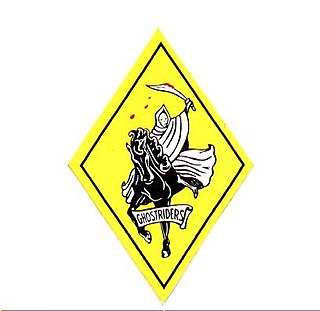
VF-142 Ghostriders was a US Navy fighter squadron established on 24 August 1948 as VF-193, it was redesignated VF-142 on 15 October 1963, and disestablished on 30 April 1995.
The Grumman F-14 Tomcat has served with the United States Navy and the Imperial Iranian Air Force, then the Islamic Republic of Iran Air Force after 1979. It operated aboard U.S. aircraft carriers from 1974 to 2006 and remains in service with Iran. In-depth knowledge of its service with Iran is relatively limited.
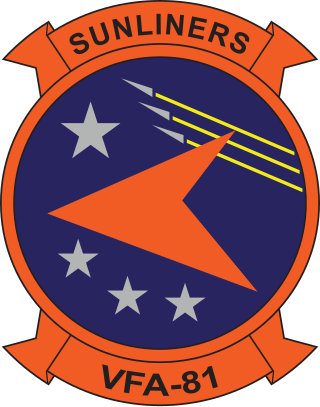
Strike Fighter Squadron 81 (VFA-81), also known as the "Sunliners", is a United States Navy F/A-18E Super Hornet strike fighter squadron stationed at Naval Air Station Oceana. They are currently assigned to Carrier Air Wing 1. Their mission is to conduct prompt and sustained combat operations from the sea. The squadron was originally designated VA-66 on 1 July 1955, was redesignated VF-81 the same day, redesignated VA-81 on 1 July 1959, and finally redesignated VFA-81 on 4 February 1988.

Carrier Air Wing Eleven (CVW-11) is a United States Navy aircraft carrier air wing based at Naval Air Station Lemoore, California. The air wing is attached to the aircraft carrier USS Theodore Roosevelt.

In the Action in the Gulf of Sidra, codenamed Operation Prairie Fire, the United States Navy deployed aircraft carrier groups in the disputed Gulf of Sidra in the Mediterranean Sea. Libya had claimed that the entire Gulf was their territory, at 32° 30' N, with an exclusive 62 nautical miles fishing zone. Libyan leader Muammar Gaddafi asserted this in 1973, and dubbed it "The Line of Death". The United States claimed its rights to conduct naval operations in international waters, a standard of 12-nautical-mile territorial limit from a country's shore. This engagement followed the 1981 Gulf of Sidra incident and preceded another in 1989.
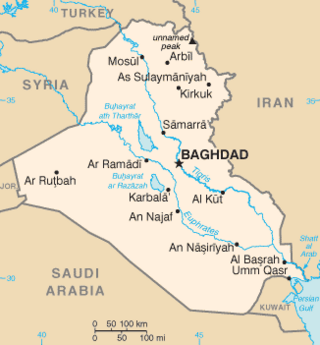
Operation Sultan 10 was an operation of the Islamic Republic of Iran Air Force (IRIAF) on 29 October 1980, the beginning of the Iran–Iraq War. In this operation six F-4E Phantom IIs from IRIAF's 32nd and 33rd Squadrons took part in an attack on the Al-Hurriah Airbase near Mosul in Saddam Hussein's Iraq.
